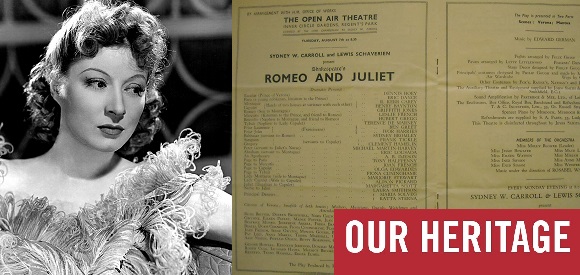Add a comment
Please note that all comments are moderated. Your email address will not be displayed and will never be shared with anyone.
By Open Air Theatre

Published: 13 Feb 2020
The first production of Romeo and Juliet in Regent’s Park took place in 1934, back when the stage was no more than a clearing of grass bank and the auditorium was made up of deck chairs and slatted park chairs. The production featured Griffith Jones and Margaretta Scott in the titular roles, but it was a name listed further down the programme that really caught our eye: in the ensemble listing was a one Greer Garson.
Greer Garson would go on to become a significant motion picture star of the 1940s, garnering fame for films such as Goodbye, Mr. Chips (1939), Pride and Prejudice (1940) and Mrs. Miniver (1942). She ultimately received seven Oscar nominations and holds two key records to her name.
The Academy of Motion Picture Arts & Sciences awards database confirms that, along with Bette Davis, Greer Garson holds the record for the most consecutive Best Actress nominations at the Oscars, with five consecutive nominations in total:
Greer Garson Consecutive Best Actress Oscar Nominations Blossoms in the Dust (1941) Mrs. Miniver (1942, won) Madame Curie (1943) Mrs. Parkington (1944) The Valley of Decision (1945)
Her other record came with her 1943 Oscar win: Best Actress for her most notable role in Mrs. Miniver (1942). In their obituary, The Independent notes, “Garson made cinema history by making an acceptance speech that lasted 45 minutes: new rules were brought in to stop this happening thereafter” – although The Washington Post maintains that the speech was actually only seven minutes long – as suggested by a historian at The Academy of Motion Picture Arts & Sciences. In his book, A Rose for Mrs. Miniver: The Life of Greer Garson, Michael Troyan claims the speech was, in fact, five and a half minutes long: “Greer quickly apologised for being unprepared (“I feel just like Alice in Wonderland”), and then launched into a five-and-a-half-minute speech that would become legendary. It seemed as though she thanked everyone who came to mind, from her Hollywood peers at MGM to the doctor who delivered her into the world in London.” However long the speech really was, it seems to be agreed that all future award-winners had Ms. Garson to thank for the “wrap it up” signals they receive during their speeches.
Prior to her ‘discovery’ by the head of Metro-Goldwyn-Mayer, Louis B. Mayer, Garson was a successful stage actress. She made her debut at Birmingham Repertory Theatre in 1932 at the age of 27 before later appearing in the Regent’s Park 1934 season including the first production of Romeo and Juliet. Her start at the Open Air Theatre was not a straightforward one, as documented by biographer Michael Troyan, “With little to do, Greer laid siege to Sydney Carroll’s office regularly, urging him to give her a chance in a featured role. Carroll finally acquiesced, casting her, despite assistant director Maxwell Wray’s protestations, as Hermia in A Midsummer Night’s Dream. With less than a week to memorize her part, Greer spent every moment preparing for her featured debut on June 19. After waiting a few days to receive her summons, she went down to the theater. To her utter surprise, she found the company already in rehearsals. Catching sight of her, Wray yelled out, “Where the hell have you been?” in front of the startled company. Taking her aside, he insisted that he had been unable to contact her and had recast Margaretta Scott as Hermia. She could work as the understudy or not at all. Needing the money – and too nonplussed to defend herself – she swallowed her pride and accepted the part, which included a walk-on role carrying garlands of roses – the female equivalent of a spear-carrier… Carroll was not able to find another part for her until Shakespeare’s Romeo and Juliet opened on August 7. Again she would be an extra.”
Troyan goes on to document the first time Greer became aware of Louis B. Mayer’s presence in London, “On July 31, haunting the backstage dressing rooms before Romeo and Juliet, she found her coworkers clustered together around the latest copy of the Daily Telegraph. Louis B. Mayer, head of Metro-Goldwyn-Mayer, America’s most powerful motion picture studio, was in London, planning to build an Anglo-American film industry alliance.” It would be the 1937 West End play Old Music that would eventually get Greer noticed by Mayer and the film studio – launching her film career.
Romeo and Juliet 1934 Featured Cast List* Dennis Hoey (Escalus), Eric Dance (Paris), R. Kerr Carey (Montague), Henry Baynton (Capulet), Griffith Jones (Romeo), Leslie French (Mercutio), Hubert Gregg (Benvolio), Terence de Marney (Tybalt), Ben Greet** (Friar Lawrence), Sydney Bromley (Balthasar), Frank Tickle (Sampson), Laura Smithson (Nurse), Marjorie Stewart (Lady Montague), Alison Pickard (Lady Capulet), Margaretta Scott (Juliet). Greer Garson was billed as an extra.
as per A Rose for Mrs. Miniver: The Life of Greer Garson by Michael Troyan *Another significant figure from this cast is Ben Greet (Friar Lawrence). During his time as Manager of the Old Vic Theatre (1915-1918), Greet presented 33 Shakespearean productions with the focus of changing children’s experience of Shakespeare – work that would later see him knighted by King George V in 1929.
Garson marks the first of many stellar names to take to the Open Air Theatre stage before becoming household names, with the likes of Vivien Leigh, Ralph Fiennes, Penelope Keith and Hugh Bonneville to name just a small selection.
Discover more of our history from our archive. Find out more about the 2020 production of Romeo and Juliet
Please note that all comments are moderated. Your email address will not be displayed and will never be shared with anyone.